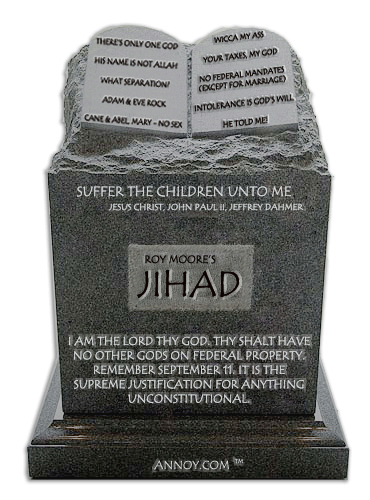
 | ||||||

Tuesday, August 26, 2003
Roy's Rock and Alabama's Role
by Clinton Fein
 On Friday, August 22, 2003, an Alabama commission that monitors judicial conduct, suspended the chief justice of the state's Supreme Court, Roy Moore, over his defiance of a U.S. order to remove a Ten Commandments monument from the state courthouse. On Friday, August 22, 2003, an Alabama commission that monitors judicial conduct, suspended the chief justice of the state's Supreme Court, Roy Moore, over his defiance of a U.S. order to remove a Ten Commandments monument from the state courthouse.
As Moore met with the commission, approximately a hundred of his supporters, several blocks away at the federal courthouse, ripped and burned copies of U.S. District Judge Myron Thompson's order for the monument's removal. Judge Thompson ruled last year that the monument, installed by Moore himself in a highly visible public spot in the state building, violates the constitution's ban on government promotion of a religious doctrine. After Moore refused to move it, eight associate justices overruled him and ordered it out of the rotunda. The battle over the display of the Ten Commandments in Alabama’s State judicial building, and the surrounding furor designed, as intended, to create a free storm of publicity for Roy Moore is missing an important point. In an editorial written by Moore for, OpinionJournal, (the shrill web editorial component of The Wall Street Journal), Moore argues that the Alabama constitution itself is based on and evokes the acknowledgment of God. “The Alabama Constitution specifically invokes ‘the favor and guidance of Almighty God’ as the basis for our laws and justice system. As the chief justice of the state's supreme court I am entrusted with the sacred duty to uphold the state's constitution. I have taken an oath before God and man to do such, and I will not waver from that commitment,” he wrote. He may have a point. To pretend that God does not exist in the exercise of judicial functions, both at a state and federal level, is to delude oneself. Upon becoming an American citizen, I recall puzzling over the notion of swearing to God to uphold a constitution from enemies foreign and domestic –- a constitution that supposedly rejected the idea of establishing a religion or that purported to represent a separation of Church and State. To who's God was I swearing? As the Bush administration prepares to both initiate faith-based programs – one’s under which radical extremists, religious fundamentalists of every stripe and terrorists will gleefully exploit every last loophole of which there are bound to plenty -- and sign constitutional amendments relating to the God-ordained sanctity of marriage between men and women only, the question of the First Amendment’s promise to uphold the exercise of free religion, not the pretense that religions does not exist, will become as important an issue as ever. As Roy Moore exploits the hysteria surrounding his obvious and misguided crusade, rousing religious extremists and bigots in a state that not long ago prohibited the use of dildos until the much-mocked “Dildo Law” was eventually struck down; one has to question the methodology as to how things work in Alabama. In his highfalutin, godly, do-gooder, holier than thou, self-imposed martyrdom, Roy Moore waxes piety in the supposed interests of the people of Alabama. “By subjugating the people of Alabama to the unconstitutional edict by Judge Thompson, that public officials may not acknowledge God, the attorney general and my colleagues have made the fiat opinion of a judge supreme over the text of the Constitution,” he opined. Yet, how on earth, in God’s name, did the god-awful, headstone-resembling, 5300 pound slab of granite representing the Ten Commandments come to be displayed in a building owned by the people of Alabama? Richard Hahnemann, a Huntsville web-designer-turned-sculptor designed the Ten Commandments monument specifically after being commissioned to do so by Alabama Chief Justice Roy Moore. "He wanted something that would show connections between the Ten Commandments and the Constitution," Hahnemann reportedly told the Mobile Register, an Alabama newspaper. Hahnemann declined to reveal the monument's cost but said it was paid for entirely with private funds, claiming to have refused payment for his design work. He then apparently assisted in sneaking in and placing the two-ton monument, which despite rumors, is not actually glued or affixed to the floor of the rotunda where it is displayed. The big question Alabama should be asking, is not so much whether the state has a right to display in public, a granite sculpture that references a Judeo-Christian construct, but whether any public official, including a Supreme Court Justice, has the right to unilaterally decide to display, without a process that includes input from the public, any art they feel like. If one public official can assert his belief in the sovereignty of his God over the authority of a sectarian government whose laws he must judge, what’s to prevent a colleague from commissioning, and placing alongside what’s come to be known as Roy’s Rock, a marble bust of Charles Darwin? If a referendum were held, the question over the display of the Ten Commandments would be in the hands of the people of Alabama, and the controversy would dissolve immediately. If Roy Moore has his way however, any public official, no matter who they are, can unilaterally decide to sneak into any public building in the middle of the night, and pepper any wall or rotunda with any art they feel is appropriate, without any kind of formal procedure. I have a couple of great ideas, should any public official be wondering. Clinton Fein can be reached at clinton@annoy.com |
© Copyright 1997-2025 ApolloMedia Corporation. All Rights Reserved. annoy.com Site Information |